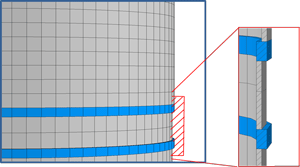
Bonded Joint Element
Adhesively bonded joints are becoming more important with the increased use of fiber-reinforced composite materials. Joints often play a critical role, and an accurate prediction of joint strength and stress is vital to vehicle design. Stress concebtrations at joint edges require detailed finite element analysis to predict, but vehicle-scale design models are too coarse to include bonded joints. To include the analysis of bonded joints in coarse finite element analysis, structural models for bonded joints are used to determine shape functions a priori, allowing stresses to be accurately captured with a single element. Geometric nonlinearity (large rotations) and crack growth have further been implemented.
A further area of interest includes using functionally graded materials to increase joint strength. The graded material can serve to spread out the stress more evenly along the joint, and initial experiments have yielded strength gains of 10%. Clearly, there is a need to develop such a joining process to improve confidence in adhesive joining and reduce the weight of primary load bearing composite structures.
